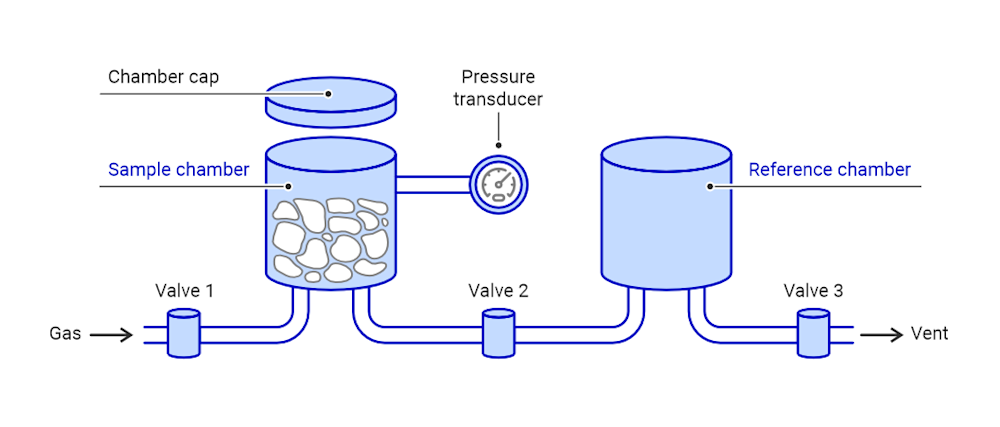Gas pycnometry
Gas pycnometry is an analytical method used to determine the volume and density of various types of solid samples. Helium is the gas most commonly used during the measurement, which is why the technique is also known as helium pycnometry.

Some of our gas pycnometry services
Skeletal density by gas pycnometry
Volume-specific surface area (VSSA) of powders
Prices excluding VAT.
- Fast turnaround times
- Personal service from method experts
- Competitive prices
- Result accuracy guarantee
What is pycnometry used for?
In general, there are two kinds of density: bulk and skeletal. Bulk density is determined including the open and closed pores of the material. Skeletal density calculation excludes the open pores, thus including only the “skeleton” of the material. Gas pycnometry is a technique employed to determine the skeletal density of solid substances, particularly in powder form.
By comparing the densities of different batches of the product, it is possible to deduce information about the encapsulation of air in closed pores within the sample, which may be a sign of compromised product quality. This makes gas pycnometry valuable in the research and development of polymers, catalysts, ceramics, films, coatings, and various other materials with varying degrees of porosity.
Helium pycnometry data can be combined with specific surface area data obtained from a BET measurement. As a result, it is possible to calculate the volume-specific surface area (VSSA), which can be used to determine whether the material has nanoscale properties. Nanomaterial identification is a key part of the compliance testing of cosmetics, food, and feed, as an extended safety assessment is required when these products contain nanoparticles.
How does a gas pycnometer work?
The gas pycnometer is comprised of two connected chambers of known volume. The sample is placed into the first chamber, which is then filled with an inert gas, most often helium. The volume of gas required to fill the rest of the chamber and the pressure within the chamber are recorded. The gas is then allowed to flow into the reference chamber of a known volume, and the change in pressure is recorded.
Knowing the volume of the gas and the pressure difference, the pycnometer will automatically calculate the volume of the sample using Boyle's law. When the mass of the sample is known before the measurement, the density can be calculated simultaneously.

Helium vs. other gasses
Pycnometry is performed with an inert gas, as any interactions between the gas and the sample would alter the results. Helium is most commonly used, but other gasses including nitrogen, carbon dioxide, and sulfur hexafluoride can also be used, based on which gas has the lowest propensity to interact with the sample.
Advantages and limitations of gas pycnometry
Gas pycnometry offers a highly accurate and reproducible method of measuring volume and density. The technique is suitable for a wide variety of solid sample types and is typically non-destructive.
The gas cannot, however, penetrate any closed pores the sample may contain. Instead of true volume, therefore, gas pycnometry provides the skeletal volume, meaning the combined volume of the material and the closed pores.
Need an analysis?
Measurlabs offers He pycnometry measurements as a part of nanomaterial identification and analysis by EFSA's guidelines. Other applications are also possible, please contact us through the form below to request a quote. We process even large sample batches with speed, enabling you to get the insights you need without unnecessary delays.
Suitable sample matrices
- Powders
- Granules
- Ceramics
- Catalysts
- Polymers
Applications of helium pycnometry
- Determining sample volume and density
- Estimating closed pore formation
- Volume specific surface area measurement (together with BET analysis)
Ask for an offer
Fill in the form, and we'll reply in one business day.
Have questions or need help? Email us at info@measurlabs.com or call our sales team.
Frequently asked questions
Helium pycnometry is commonly used to compare the true densities of material batches to the theoretical value, therefore deducing information about the porosity of each batch. This is useful for quality control in industries including polymers, ceramics, and construction materials.
Together with a BET measurement, pycnometry also provides data that can be used for nanomaterial identification in the food, feed, and cosmetics industries.
Measurlabs offers a variety of laboratory analyses for product developers and quality managers. We perform some of the analyses in our own lab, but mostly we outsource them to carefully selected partner laboratories. This way we can send each sample to the lab that is best suited for the purpose, and offer high-quality analyses with more than a thousand different methods to our clients.
When you contact us through our contact form or by email, one of our specialists will take ownership of your case and answer your query. You get an offer with all the necessary details about the analysis, and can send your samples to the indicated address. We will then take care of sending your samples to the correct laboratories and write a clear report on the results for you.
Samples are usually delivered to our laboratory via courier. Contact us for further details before sending samples.